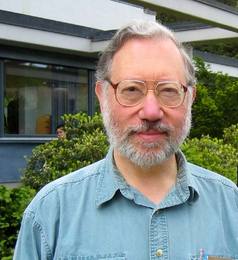Knotting and linking occurs in the tangling of ropes in physical space
and the earliest human technologies utilized weaving and knotting in the
making structures for containment, clothing and binding. Only since the
time of Faraday, Maxwell and Kelvin, however, have knots begun to figure
in physical and mathematical science. Faraday saw that electric and
magnetic fields are literally linked with one another and further
developments featured in the work of Gauss and Maxwell. From there
Gauss then Riemann then Poincare developed the subject of topology and
by 1900 it was possible to study knots using topology. A significant
reconnection with physics occurred in the 1980.s work of Vaughan Jones
connecting knot theory and statistical mechanics and with the work of
Edward Witten connecting knot invariants with quantum field theory.
Since that time there has been an extraordinary interplay of work
relating knots and physics and natural science. Some of this work goes
back to fundamental questions about knots as physical entities with
length and thickness, elasticity and bendability. Some of it goes more
deeply into the relationships with statistical mechanics, combinatorics,
quantum field theory and new forays into algebraic topology undreamed of
in the age of Faraday and Maxwell. Possible applications loom in quantum
computing, molecular biology and elsewhere in pure mathematics and the
sciences. This talk will be a pictorial introduction to these
revolutions.

Play Flash full motion video, or Flash lower bandwidth video.
 (Or, right-click to download the 3gp file.)
(Or, right-click to download the 3gp file.)
Play QuickTime full motion movie
[ or Stream |
or Download ]
Or play QuickTime lower bandwidth slideshow
[ or Download ]
Or [ Download the Podcast ].

Begin streaming RealMedia.
(Or, right-click to download the audio file.)

To begin viewing slides, click on the first slide below. (Or, view as pdf.)
![[01]](tn/01.jpg)
![[02]](tn/02.jpg)
![[03]](tn/03.jpg)
![[04]](tn/04.jpg)
![[05]](tn/05.jpg)
![[06]](tn/06.jpg)
![[07]](tn/07.jpg)
![[08]](tn/08.jpg)
![[09]](tn/09.jpg)
![[10]](tn/10.jpg)
![[11]](tn/11.jpg)
![[12]](tn/12.jpg)
![[13]](tn/13.jpg)
![[14]](tn/14.jpg)
![[15]](tn/15.jpg)
![[16]](tn/16.jpg)
![[17]](tn/17.jpg)
![[18]](tn/18.jpg)
![[19]](tn/19.jpg)
![[20]](tn/20.jpg)
![[21]](tn/21.jpg)
![[22]](tn/22.jpg)
![[23]](tn/23.jpg)
![[24]](tn/24.jpg)
![[25]](tn/25.jpg)
![[26]](tn/26.jpg)
![[27]](tn/27.jpg)
![[28]](tn/28.jpg)
![[29]](tn/29.jpg)
![[30]](tn/30.jpg)
![[31]](tn/31.jpg)
![[32]](tn/32.jpg)
![[33]](tn/33.jpg)
![[34]](tn/34.jpg)
![[35]](tn/35.jpg)
![[36]](tn/36.jpg)
![[37]](tn/37.jpg)
![[38]](tn/38.jpg)
![[39]](tn/39.jpg)
![[40]](tn/40.jpg)
![[41]](tn/41.jpg)
![[42]](tn/42.jpg)
![[43]](tn/43.jpg)
![[44]](tn/44.jpg)
![[45]](tn/45.jpg)
![[46]](tn/46.jpg)
![[47]](tn/47.jpg)
![[48]](tn/48.jpg)
![[49]](tn/49.jpg)
![[50]](tn/50.jpg)
![[51]](tn/51.jpg)
![[52]](tn/52.jpg)
![[53]](tn/53.jpg)
![[54]](tn/54.jpg)
![[55]](tn/55.jpg)
![[56]](tn/56.jpg)
![[57]](tn/57.jpg)
![[58]](tn/58.jpg)
![[59]](tn/59.jpg)
![[60]](tn/60.jpg)
![[61]](tn/61.jpg)
![[62]](tn/62.jpg)
![[63]](tn/63.jpg)
![[64]](tn/64.jpg)
![[65]](tn/65.jpg)
![[66]](tn/66.jpg)
![[67]](tn/67.jpg)
![[68]](tn/68.jpg)
![[69]](tn/69.jpg)
![[70]](tn/70.jpg)
![[71]](tn/71.jpg)
![[72]](tn/72.jpg)
![[73]](tn/73.jpg)
![[74]](tn/74.jpg)
![[75]](tn/75.jpg)
![[76]](tn/76.jpg)
![[77]](tn/77.jpg)
![[78]](tn/78.jpg)
![[79]](tn/79.jpg)
![[80]](tn/80.jpg)
![[81]](tn/81.jpg)
![[82]](tn/82.jpg)
![[83]](tn/83.jpg)
![[84]](tn/84.jpg)
![[85]](tn/85.jpg)
![[86]](tn/86.jpg)
![[87]](tn/87.jpg)
![[88]](tn/88.jpg)
![[89]](tn/89.jpg)
![[90]](tn/90.jpg)
![[91]](tn/91.jpg)
![[92]](tn/92.jpg)
![[93]](tn/93.jpg)
![[94]](tn/94.jpg)
![[95]](tn/95.jpg)
![[96]](tn/96.jpg)
![[97]](tn/97.jpg)
![[98]](tn/98.jpg)
![[99]](tn/99.jpg)
![[100]](tn/100.jpg)
![[101]](tn/101.jpg)
![[102]](tn/102.jpg)
![[103]](tn/103.jpg)
![[104]](tn/104.jpg)
![[105]](tn/105.jpg)
![[106]](tn/106.jpg)
![[107]](tn/107.jpg)
![[108]](tn/108.jpg)
![[109]](tn/109.jpg)
![[110]](tn/110.jpg)
![[111]](tn/111.jpg)
![[112]](tn/112.jpg)
![[113]](tn/113.jpg)
![[114]](tn/114.jpg)
![[115]](tn/115.jpg)
![[116]](tn/116.jpg)
![[117]](tn/117.jpg)
![[118]](tn/118.jpg)
![[119]](tn/119.jpg)
![[120]](tn/120.jpg)
![[121]](tn/121.jpg)
![[122]](tn/122.jpg)
![[123]](tn/123.jpg)
![[124]](tn/124.jpg)
![[125]](tn/125.jpg)
![[126]](tn/126.jpg)

